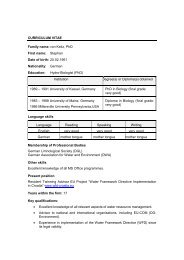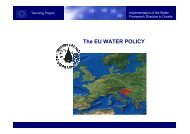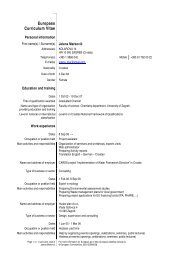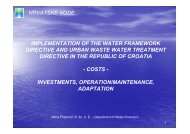BIODIVERSITY OF CROATIA
BIODIVERSITY OF CROATIA
BIODIVERSITY OF CROATIA
Create successful ePaper yourself
Turn your PDF publications into a flip-book with our unique Google optimized e-Paper software.
BIRDS<br />
Croatia’s ornythofauna is amongst the richest in Europe when<br />
considering the 78 bird species which breed in Croatia and are<br />
threatened at the European level. The total number of bird species<br />
is 375 and of these, 234 breed on Croatian territory.<br />
Croatia’s ornythofauna includes 130 species listed in Annex I<br />
of the Birds Directive. There are 39 sites that satisfy BirdLife<br />
International Criteria for Important Bird Areas for Europe, covering<br />
40% of Croatian territory. They all qualify for NATURA<br />
2000 sites which indicate Croatia’s great responsibility for the<br />
protection of European ornythofauna.<br />
Some species highly threatened in Europe are represented with<br />
significant populations in Croatia. This is mostly due to the large<br />
areas of preserved habitats. There are still large wetland com-<br />
plexes along the lowland Drava and Sava Rivers that are extremely<br />
important for the breeding of wetland species such as the<br />
spoonbill, herons and terns, the white-tailed eagle, black and<br />
white stork and lesser spotted eagle. Globally threatened species<br />
like the corncrake, dependent on large wet grasslands, or the ferruginous<br />
duck which nests along the old oxbows and extensive<br />
fishponds, are very well represented in Croatia. Natural and artificial<br />
wetlands, especially carp fishponds, represent internationally<br />
important migration and wintering sites for European waterfowl.<br />
Large complexes of beech and fir forests in the mountain areas<br />
of Croatia are important for numerous owl species, woodpeckers,<br />
the capercaillie, golden eagle and others. The coastal area is also<br />
inhabited with certain important species like the griffon vulture,<br />
the Eleonora falcon, Audonii’s gull and others.<br />
Spoonbill (Platalea leucorodia) inhabits Croatian carp fishponds and<br />
natural wetlands (photo: B. Krstini})<br />
Peregrine falcon (Falco peregrinus) breeds in the middle of the<br />
Croatian capital Zagreb (photo: M. Cukrov)<br />
Corncrake (Crex crex), the globally threatened bird of wet meadows<br />
(photo: S. Harvancik)<br />
Croatian carp fishponds are extremely important for globally<br />
threatened ferruginous duck (Aythya nyroca) (photo: D. Krnjeta)<br />
11









